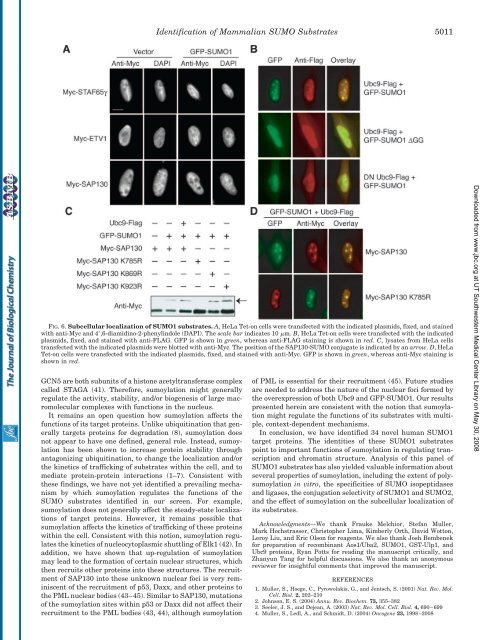Systematic Identification and Analysis of ... - UT Southwestern
Systematic Identification and Analysis of ... - UT Southwestern
Systematic Identification and Analysis of ... - UT Southwestern
You also want an ePaper? Increase the reach of your titles
YUMPU automatically turns print PDFs into web optimized ePapers that Google loves.
<strong>Identification</strong> <strong>of</strong> Mammalian SUMO Substrates 5011<br />
FIG. 6.Subcellular localization <strong>of</strong> SUMO1 substrates. A, HeLa Tet-on cells were transfected with the indicated plasmids, fixed, <strong>and</strong> stained<br />
with anti-Myc <strong>and</strong> 4,6-diamidino-2-phenylindole (DAPI). The scale bar indicates 10 m. B, HeLa Tet-on cells were transfected with the indicated<br />
plasmids, fixed, <strong>and</strong> stained with anti-FLAG. GFP is shown in green, whereas anti-FLAG staining is shown in red. C, lysates from HeLa cells<br />
transfected with the indicated plasmids were blotted with anti-Myc. The position <strong>of</strong> the SAP130-SUMO conjugate is indicated by an arrow. D, HeLa<br />
Tet-on cells were transfected with the indicated plasmids, fixed, <strong>and</strong> stained with anti-Myc. GFP is shown in green, whereas anti-Myc staining is<br />
shown in red.<br />
GCN5 are both subunits <strong>of</strong> a histone acetyltransferase complex<br />
called STAGA (41). Therefore, sumoylation might generally<br />
regulate the activity, stability, <strong>and</strong>/or biogenesis <strong>of</strong> large macromolecular<br />
complexes with functions in the nucleus.<br />
It remains an open question how sumoylation affects the<br />
functions <strong>of</strong> its target proteins. Unlike ubiquitination that generally<br />
targets proteins for degradation (8), sumoylation does<br />
not appear to have one defined, general role. Instead, sumoylation<br />
has been shown to increase protein stability through<br />
antagonizing ubiquitination, to change the localization <strong>and</strong>/or<br />
the kinetics <strong>of</strong> trafficking <strong>of</strong> substrates within the cell, <strong>and</strong> to<br />
mediate protein-protein interactions (1–7). Consistent with<br />
these findings, we have not yet identified a prevailing mechanism<br />
by which sumoylation regulates the functions <strong>of</strong> the<br />
SUMO substrates identified in our screen. For example,<br />
sumoylation does not generally affect the steady-state localizations<br />
<strong>of</strong> target proteins. However, it remains possible that<br />
sumoylation affects the kinetics <strong>of</strong> trafficking <strong>of</strong> these proteins<br />
within the cell. Consistent with this notion, sumoylation regulates<br />
the kinetics <strong>of</strong> nucleocytoplasmic shuttling <strong>of</strong> Elk1 (42). In<br />
addition, we have shown that up-regulation <strong>of</strong> sumoylation<br />
may lead to the formation <strong>of</strong> certain nuclear structures, which<br />
then recruits other proteins into these structures. The recruitment<br />
<strong>of</strong> SAP130 into these unknown nuclear foci is very reminiscent<br />
<strong>of</strong> the recruitment <strong>of</strong> p53, Daxx, <strong>and</strong> other proteins to<br />
the PML nuclear bodies (43–45). Similar to SAP130, mutations<br />
<strong>of</strong> the sumoylation sites within p53 or Daxx did not affect their<br />
recruitment to the PML bodies (43, 44), although sumoylation<br />
<strong>of</strong> PML is essential for their recruitment (45). Future studies<br />
are needed to address the nature <strong>of</strong> the nuclear foci formed by<br />
the overexpression <strong>of</strong> both Ubc9 <strong>and</strong> GFP-SUMO1. Our results<br />
presented herein are consistent with the notion that sumoylation<br />
might regulate the functions <strong>of</strong> its substrates with multiple,<br />
context-dependent mechanisms.<br />
In conclusion, we have identified 34 novel human SUMO1<br />
target proteins. The identities <strong>of</strong> these SUMO1 substrates<br />
point to important functions <strong>of</strong> sumoylation in regulating transcription<br />
<strong>and</strong> chromatin structure. <strong>Analysis</strong> <strong>of</strong> this panel <strong>of</strong><br />
SUMO1 substrates has also yielded valuable information about<br />
several properties <strong>of</strong> sumoylation, including the extent <strong>of</strong> polysumoylation<br />
in vitro, the specificities <strong>of</strong> SUMO isopeptidases<br />
<strong>and</strong> ligases, the conjugation selectivity <strong>of</strong> SUMO1 <strong>and</strong> SUMO2,<br />
<strong>and</strong> the effect <strong>of</strong> sumoylation on the subcellular localization <strong>of</strong><br />
its substrates.<br />
Acknowledgments—We thank Frauke Melchior, Stefan Muller,<br />
Mark Hochstrasser, Christopher Lima, Kimberly Orth, David Wotton,<br />
Leroy Liu, <strong>and</strong> Eric Olson for reagents. We also thank Josh Bembenek<br />
for preparation <strong>of</strong> recombinant Aos1/Uba2, SUMO1, GST-Ulp1, <strong>and</strong><br />
Ubc9 proteins, Ryan Potts for reading the manuscript critically, <strong>and</strong><br />
Zhanyun Tang for helpful discussions. We also thank an anonymous<br />
reviewer for insightful comments that improved the manuscript.<br />
REFERENCES<br />
1. Muller, S., Hoege, C., Pyrowolakis, G., <strong>and</strong> Jentsch, S. (2001) Nat. Rev. Mol.<br />
Cell. Biol. 2, 202–210<br />
2. Johnson, E. S. (2004) Annu. Rev. Biochem. 73, 355–382<br />
3. Seeler, J. S., <strong>and</strong> Dejean, A. (2003) Nat. Rev. Mol. Cell. Biol. 4, 690–699<br />
4. Muller, S., Ledl, A., <strong>and</strong> Schmidt, D. (2004) Oncogene 23, 1998–2008<br />
Downloaded from www.jbc.org at <strong>UT</strong> <strong>Southwestern</strong> Medical Center Library on May 30, 2008

















